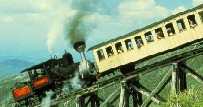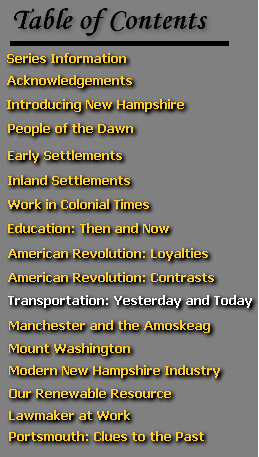SUMMARY
 This
lesson examines major means of transportation in New Hampshire, looking
at former time periods and considering the situation today. This
lesson examines major means of transportation in New Hampshire, looking
at former time periods and considering the situation today.
One of the first means of
transportation was by foot. From the Indians, the earliest settlers also
learned a style of running, which enabled one to travel long distances
without tiring. Traveling was much easier if one was fortunate enough to
own a horse. Riders used stream beds and river banks to travel by horseback.
River travel was one of the
first alternatives to walking and horseback riding. New Hampshire's rivers
also became the state's first highways. From the days of the first settlers,
small boats navigated New Hampshire's rivers: the Merrimack, the Connecticut,
the Saco, and the Androscoggin. The lake system around Winnipesaukee and
the six rivers which empty into Great Bay were well-travelled waterways.
These natural highways encouraged the growth of farm villages into cities.
Towns grew where goods could be moved easily on the water near them: Manchester,
Nashua, Laconia, Exeter, Dover, Lebanon, and Portsmouth.
As New Hampshire settlers
looked for new places to live, movement was away from the river. This brought
about the need for new roads. Governor John Wentworth was responsible for
much of New Hampshire's early road construction. By 1771, there were over
200 miles of road in New Hampshire.
The rivers, however, continued
to be a major means of transportation. In 1807, a canal bypassed the rapids
on the Merrimack River, enabling the Amoskeag Mills to become the largest
textile mill in the world.
On the high seas, New Hampshire-built
clipper ships became world famous as a comfortable means of transporting
cargo and passengers. Steam-powered boats traveled the inland rivers, as
well as the New England coast. As early as 1793, Samuel Morey from Orford
was running a steamboat on the Connecticut River.
By the early 1800s an efficient
network of "turnpikes" or toll roads was built in New Hampshire. A lighter
and faster carriage could be used on these roads. Stephen Abbott and Lewis
Downing of Concord built some of the finest carriages in the world. In
1826, the Abbott and Downing Company began manufacturing many types of
carriages, the most famous of which was the Concord Coach.
The longing for a more convenient
and comfortable way to travel from place to place over long distances led
to the spread of the railroad. In 1840, the Boston and Maine railroad entered
Exeter, and by 1850, Nashua, Manchester, Exeter, Dover, and Portsmouth
all had railroad lines to Boston. The Mt. Washington Cog Railway was constructed
in 1869, designed by Herrick Aiken of Franklin and built by Sylvester Marsh
of Littleton.
In the 1800s, the railroads
connected the cities, but within the cities, horsedrawn streetcars were
used. They were replaced by electrified trolley cars in the 1890s.
The first automobile had
a rough time, usually driving over roads intended for four-legged animals.
As the number of autos increased, the methods of road-building improved.
Soon New Hampshire became easily conquered by the automobile.
In 1911, the first airplane
was seen in New Hampshire skies. This was a non-stop flight from Waltham,
Massachusetts to Laconia, New Hampshire. In l927, the first airport was
built in Manchester, and in 1933, passenger flights first came to New Hampshire.
New Hampshire also has made
a contribution to space travel. On May 21, 1961, a Derry man, Alan Shepard,
became the first astronaut to go into outer space.
OBJECTIVES
1. To present a history
of transportation in New Hampshire from the earliest days to modern times.
2. To give students
a better understanding of the relationship between historical events and
the development of different types of transportation.
3. To make students
aware of how man's needs create new forms of transportation.
4. To suggest some
future problems New Hampshire may have in the field of transportation.
PRE-VIEWING ACTIVITIES
1. Ask students to
list various means of transportation available today.
2. Review post-lesson
activity number 4 in Lesson #3, "Work In Colonial Times."
3. Review forms of
transportation discussed in earlier programs (foot, canoe, gundalow, ox-cart,
horseback, wagon).
4. Bring pictures
and models of stagecoaches to class.
5. Ask students to
estimate how long it takes to travel by car from their town to various
points in and near New Hampshire.
POST-VIEWING ACTIVITIES
1. Draw a class mural
of different kinds of transportation used in New Hampshire.
2. Research the history
of transportation in your own town.
3. Make a paper model
of a gundalow.
4. Review reasons
for the building of canals and why they fell into disuse. Are there any
remains of old canals in your area?
5. Write a letter
home describing a trip in a stagecoach in the mid-1800s.
6. Assign students
to research and report on Thaddeus Lowe, Samuel Blodgett, and Alan Shepard.
7. Ask students to
make a collection of pictures of various forms of transportation.
8. Dramatize "Transportation:
Then and Now," showing how today's short trips were once difficult journeys.
9. Discuss how the
automobile has changed our way of life. Comment on our dependence on this
method of transportation.
10. Research and report
on the need for mass transportation in New Hampshire.
11. Debate the issue
of the individual use of mass transit to solve traffic problems.
12. Ask students to
write or draw descriptions of future forms of New Hampshire transportation.
VOCABULARY
PLACES TO KNOW
-
Merrimack River
-
Manchester
-
Somersworth
-
Connecticut River
-
Nashua
-
Orford
-
Saco River
-
Laconia
-
Concord
-
Androscoggin River
-
Exeter
-
Mt. Washington
-
Winnepesaukee
-
Dover
-
Keene
-
Great Bay
-
Lebanon
-
Derry
-
Portsmouth
IMPORTANT DATES
| By
1771 |
Over 200 miles of roads
were finished in New Hampshire. |
| 1793 |
Samuel Morey running
a steampowered boat on the Connecticut River. |
| 1793 |
Samuel Blodgett proposes
canal on Merrimack River. |
| 1807 |
Canal completed. |
| 1826 |
Abbott & Downing
Company begins manufacturing carriages. |
| 1835 |
New Hampshire legislature
offers grant to build railway line from Massachusetts to Maine through
New Hampshire. |
| 1851 |
Three clipper ships built
at Portsmouth shipyard. |
| 1899 |
First electric trolley
in New Hampshire. |
| 1911 |
First airplane in New
Hampshire skies. |
| 1927 |
First airport built in
New Hampshire. |
| 1933 |
First passenger flights
come to New Hampshire. |
WEB RESOURCES
|




